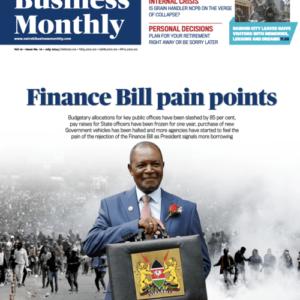BY ANTONY MUTUNGA
The year 2017 was a difficult one for Kenya. We faced many obstacles to growth among them a prolonged and bruising electioneering period which saw almost everything in the country get affected.
The most affected part was our economy as perceived by several international agencies that as a result, they brought down their growth projection for the country. The World Bank downgraded their earlier projection of 5.5% to 4.9% while the International Monetary Fund (IMF) changed its earlier projection from 5.3% to 5.0%.
Download Nairobi Business Monthly Latest Edition
However, not all agencies believed that the prolonged electioneering period was the main reason behind the declining nature of the country’s economy. For instance, global rating agency Moody’s placed Kenya’s B1 rating on review for a downgrade in 2017. They accredited their review for a downgrade to different problems affecting the country such as persistent high primary deficit & high borrowing costs, government’s liquidity pressure, tense political situation and uncertainties over the future direction of her economic and fiscal policy.
With no signs of a change in sight, in 2018 the global credit rating agency has decided to downgrade the country’s credit scores. This saw the issuer rating of the Kenyan government being downgraded from B1 to B2 rating but with a stable outlook. The major reason behind the downgrading was the continuous erosion of the fiscal strength in the country as the result of an increase in the primary deficit in conjunction with the worsening debt affordability and the ever-rising debt levels.
The current level of debt in the country has been on an upward trend for quite a while, in the fiscal year 2011/2012 the debt was 41% of the GDP however five years down the line, the debt rose to 56% of the GDP in the fiscal year 2016/2017. As a result of large infrastructure needs and a subdued revenue collection, the level of debt is expected to keep raising as Moody’s projects it to grow to 61% of the GDP in the fiscal year 2018/2019.
In addition, this causes the primary deficit to remain high as the government’s expenditure is higher compared to the revenue collected. In the FY 2016/2017, this saw the primary deficit standing at 5.3% of the GDP and in the next two years the rate is not expected to fall as Moody’s forecasts it to remain above 4% of the GDP.
On the other hand, debt affordability, which refers to a government’s ability to repay its bonded indebtedness without overly constricting its’ funding of other budget priorities, has been deteriorating as the share of the revenue that is used for the government’s interest payments for debts increased from 13.7% in the FY 2012/2013 to 19% in the FY 2016/2017. To make matters worse, the rate is expected to keep going up since in 2018 the share is expected to reach 20%.
This can be accredited to the fact that the country’s external debt has recently been shifting from concessional debt, which mainly refers to a debt with a low collateral requirement, longer maturity and longer grace periods, towards commercial debts, which mainly assist with short term financing needs. For instance, between 2013 and 2017, the percentage of commercial debt in the total external debt increased from 7% to 31%. This in turn has led to higher financing costs as a result of a rising interest burden.
Additionally, the country is also expected to continue facing liquidity pressures as a result of dependence on financing avenues that have less predictable costs and increasing financing needs. As the country continues to depend on commercial external borrowing and short-term domestic debts, it continues to increase its risk of financial stress. This is because in the next few years the loans it has taken out will begin to mature thus rising Kenya’s financing needs as interest rate they are meant to pay increases.
In April, for instance, a syndicated loan worth $750 million which was taken out in 2015 is expected to mature, next year in June the country’s first Eurobond worth $750 million (Sh7.64b) is also expected to mature while the second Eurobond worth $2 billion is expected to mature in 2024. This will definitely see the financing needs for the country shoot up and with the level having already reached 19% of the GDP in the FY 2016/2017; it is only expected to go higher in the FY 2018/2019 with Moody’s even projecting it to reach 22% of the GDP.
Despite all this, the agency has given Kenya a stable outlook for its economic strength and diversified economy, stating that it provides some capacity to be able to absorb the economic shocks. However, the agency has also cautioned that the current government policy of improving efficiency in terms of expenditure and revenue may not be quite enough to improve the current fiscal trends.



